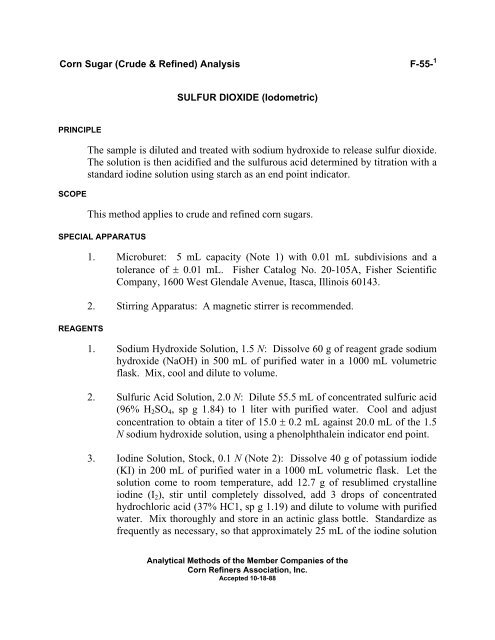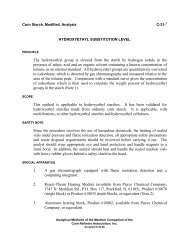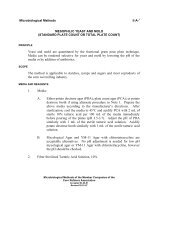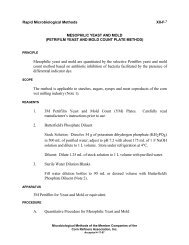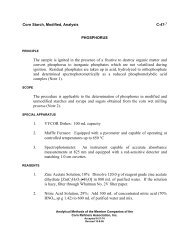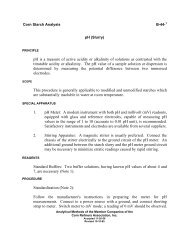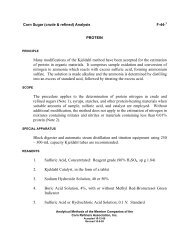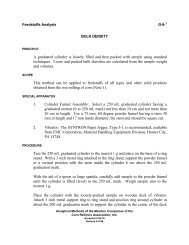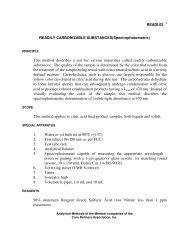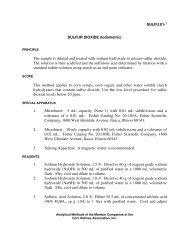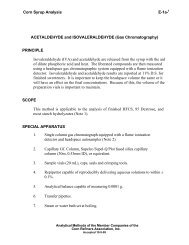The sample is diluted and treated with sodium hydroxide to release ...
The sample is diluted and treated with sodium hydroxide to release ...
The sample is diluted and treated with sodium hydroxide to release ...
You also want an ePaper? Increase the reach of your titles
YUMPU automatically turns print PDFs into web optimized ePapers that Google loves.
Corn Sugar (Crude & Refined) Analys<strong>is</strong> F-55- 1SULFUR DIOXIDE (Iodometric)PRINCIPLESCOPE<strong>The</strong> <strong>sample</strong> <strong>is</strong> <strong>diluted</strong> <strong>and</strong> <strong>treated</strong> <strong>with</strong> <strong>sodium</strong> <strong>hydroxide</strong> <strong>to</strong> <strong>release</strong> sulfur dioxide.<strong>The</strong> solution <strong>is</strong> then acidified <strong>and</strong> the sulfurous acid determined by titration <strong>with</strong> ast<strong>and</strong>ard iodine solution using starch as an end point indica<strong>to</strong>r.Th<strong>is</strong> method applies <strong>to</strong> crude <strong>and</strong> refined corn sugars.SPECIAL APPARATUSREAGENTS1. Microburet: 5 mL capacity (Note 1) <strong>with</strong> 0.01 mL subdiv<strong>is</strong>ions <strong>and</strong> a<strong>to</strong>lerance of ± 0.01 mL. F<strong>is</strong>her Catalog No. 20-105A, F<strong>is</strong>her ScientificCompany, 1600 West Glendale Avenue, Itasca, Illino<strong>is</strong> 60143.2. Stirring Apparatus: A magnetic stirrer <strong>is</strong> recommended.1. Sodium Hydroxide Solution, 1.5 N: D<strong>is</strong>solve 60 g of reagent grade <strong>sodium</strong><strong>hydroxide</strong> (NaOH) in 500 mL of purified water in a 1000 mL volumetricflask. Mix, cool <strong>and</strong> dilute <strong>to</strong> volume.2. Sulfuric Acid Solution, 2.0 N: Dilute 55.5 mL of concentrated sulfuric acid(96% H 2 SO 4 , sp g 1.84) <strong>to</strong> 1 liter <strong>with</strong> purified water. Cool <strong>and</strong> adjustconcentration <strong>to</strong> obtain a titer of 15.0 ± 0.2 mL against 20.0 mL of the 1.5N <strong>sodium</strong> <strong>hydroxide</strong> solution, using a phenolphthalein indica<strong>to</strong>r end point.3. Iodine Solution, S<strong>to</strong>ck, 0.1 N (Note 2): D<strong>is</strong>solve 40 g of potassium iodide(KI) in 200 mL of purified water in a 1000 mL volumetric flask. Let thesolution come <strong>to</strong> room temperature, add 12.7 g of resublimed crystallineiodine (I 2 ), stir until completely d<strong>is</strong>solved, add 3 drops of concentratedhydrochloric acid (37% HC1, sp g 1.19) <strong>and</strong> dilute <strong>to</strong> volume <strong>with</strong> purifiedwater. Mix thoroughly <strong>and</strong> s<strong>to</strong>re in an actinic glass bottle. St<strong>and</strong>ardize asfrequently as necessary, so that approximately 25 mL of the iodine solutionAnalytical Methods of the Member Companies of theCorn Refiners Association, Inc.Accepted 10-18-88
Corn Sugar (Crude & Refined) Analys<strong>is</strong> F-55- 2SULFUR DIOXIDE (Iodometric) ⎯ continued<strong>is</strong> equivalent <strong>to</strong> 25 mL of 0.1 N st<strong>and</strong>ard <strong>sodium</strong> thiosulfate solution usingstarch indica<strong>to</strong>r for end point detection.4. Iodine Solution, Working St<strong>and</strong>ard, 0.005 N: Using a 5 mL Class A pipet,transfer 5.0 mL of the 0.1 N s<strong>to</strong>ck iodine solution in<strong>to</strong> a 100 mL volumetricflask. Dilute <strong>to</strong> volume <strong>with</strong> purified water <strong>and</strong> mix well. Make freshdaily.5. Starch Indica<strong>to</strong>r Solution, 1%: Slurry 10 g of soluble starch (LintnerStarch, available from Sigma Chemical, P. O. Box 14508, St. Lou<strong>is</strong>,M<strong>is</strong>souri 63178) in 50 mL of cold purified water. Transfer quantitatively <strong>to</strong>1 L of boiling purified water <strong>and</strong> stir until completely d<strong>is</strong>solved. Cool <strong>and</strong>add 1 g of salicyclic acid preservative. D<strong>is</strong>card after one month.PROCEDUREWeigh accurately 100 g of corn sugar in<strong>to</strong> a 250 mL Erlenmeyer flask; weigh 50 gif the sulfur dioxide level <strong>is</strong> more than 8 ppm. Add sufficient purified water <strong>to</strong>bring <strong>to</strong>tal weight <strong>to</strong> 200 g (Note 3). Mix the sugar <strong>and</strong> water until the solution <strong>is</strong>homogenous. Cool <strong>to</strong> 10 °C or below (Note 4).Place cold <strong>sample</strong> on a magnetic stirrer <strong>and</strong> stir at a rate sufficient <strong>to</strong> produce asmall vortex at the solution surface. Add 10 mL of cold 1.5 N <strong>sodium</strong> <strong>hydroxide</strong>solution <strong>and</strong> stir for 15 <strong>to</strong> 20 seconds. Add 10 mL of starch indica<strong>to</strong>r solution(Note 5) <strong>and</strong> 10 mL of cold 2.0 N sulfuric acid solution; titrate immediately <strong>with</strong>0.0005 N st<strong>and</strong>ard iodine solution until a light blue color pers<strong>is</strong>ts for one minute.Perform a blank titration using 200 mL of purified water <strong>and</strong> all reagents.CALCULATIONSulfur Dioxide, ppm, as <strong>is</strong> ==(Sample Titer, mL - Blank Titer, mL) × N Iodine × 0.032* × 1,000,000Sample Wt., (g)*Milliequivalent Weight of Sulfur Dioxide =64.072×1000
Corn Sugar (Crude & Refined) Analys<strong>is</strong> F-55- 3SULFUR DIOXIDE (Iodometric) ⎯ continuedNOTES AND PRECAUTIONS1. It <strong>is</strong> recommended that a 10 mL microburet <strong>with</strong> 0.02 mL subdiv<strong>is</strong>ions <strong>and</strong>a <strong>to</strong>lerance of ± 0.02 mL be used when analyzing <strong>sample</strong>s containing morethat 8 ppm sulfur dioxide. (F<strong>is</strong>her Catalog No. 20-105B)2. <strong>The</strong> 0.1 N s<strong>to</strong>ck iodine solution may be st<strong>and</strong>ardized against arsenioustioxide as described in the “Reagents <strong>and</strong> Indica<strong>to</strong>rs” section, Method R-10.3. To provide the best potential for detecting the v<strong>is</strong>ual end point ofvolumetric titration, constant volume <strong>is</strong> recommended. Th<strong>is</strong> eliminatesvariation due <strong>to</strong> inability <strong>to</strong> detect the end point cons<strong>is</strong>tently.4. Starch indica<strong>to</strong>r sensitivity may be lost <strong>and</strong> conversion reactions may occurunder alkaline conditions. <strong>The</strong>refore, it <strong>is</strong> necessary <strong>to</strong> cool the <strong>sample</strong>solution <strong>and</strong> keep all reagents at a temperature of 10 °C or below, in order<strong>to</strong> maintain stability.5. Some sources recommend as little as 1 mL of starch indica<strong>to</strong>r solution; 10mL <strong>is</strong> recommended in th<strong>is</strong> procedure <strong>to</strong> ass<strong>is</strong>t end point detection.


